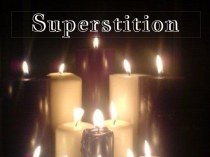- Главная
- Разное
- Бизнес и предпринимательство
- Образование
- Развлечения
- Государство
- Спорт
- Графика
- Культурология
- Еда и кулинария
- Лингвистика
- Религиоведение
- Черчение
- Физкультура
- ИЗО
- Психология
- Социология
- Английский язык
- Астрономия
- Алгебра
- Биология
- География
- Геометрия
- Детские презентации
- Информатика
- История
- Литература
- Маркетинг
- Математика
- Медицина
- Менеджмент
- Музыка
- МХК
- Немецкий язык
- ОБЖ
- Обществознание
- Окружающий мир
- Педагогика
- Русский язык
- Технология
- Физика
- Философия
- Химия
- Шаблоны, картинки для презентаций
- Экология
- Экономика
- Юриспруденция
Что такое findslide.org?
FindSlide.org - это сайт презентаций, докладов, шаблонов в формате PowerPoint.
Обратная связь
Email: Нажмите что бы посмотреть
Презентация на тему Проект “Different Countries – Similar Flowers”
Содержание
- 2. I live in a small village
- 3. I like nature very much. My favorite
- 4. Snowdrops (подснежник) have similar names, because they
- 5. One of the earliest spring flowers is
- 6. Camomile (ромашка) English name camomile is of
- 7. Morning glory (утреннее сияние) is a climbing
- 8. Bluebell (колокольчик) is a plant that grows
- 9. Cornflower (василёк) is a small wild plant
- 10. Foget-me-not (незабудка) is connected with many legends.
- 11. Sunflower (подсолнух) is a very tall
- 12. Dandelion (одуванчик) is a wild plant with
- 13. Anemone (горицвет) sprang from the blood
- 14. Narcissus or daffodil (нарцисс). The history
- 15. Aster ( астра ) a plant with
- 16. Nasturtium is actually a "nose-twister". The ancients
- 17. Rose (роза) is any of the wild
- 18. Snapdragon or dragon flowers – львиный зев (antirrinum)
- 19. The name calendula «календула» is Latin by
- 20. Daisy ( маргаритка) is a type of
- 21. In English there are other interesting names
- 22. Скачать презентацию
- 23. Похожие презентации

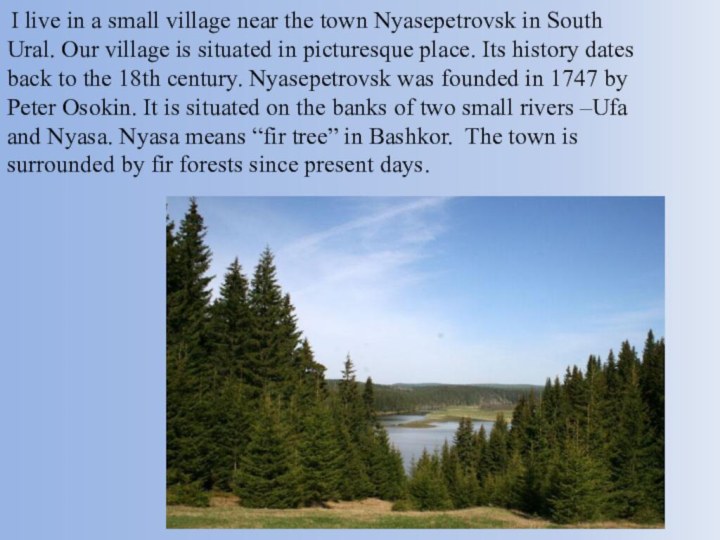
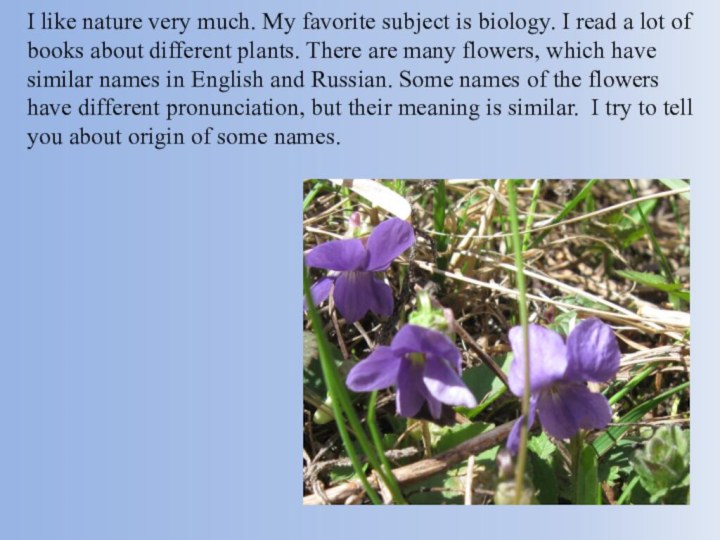
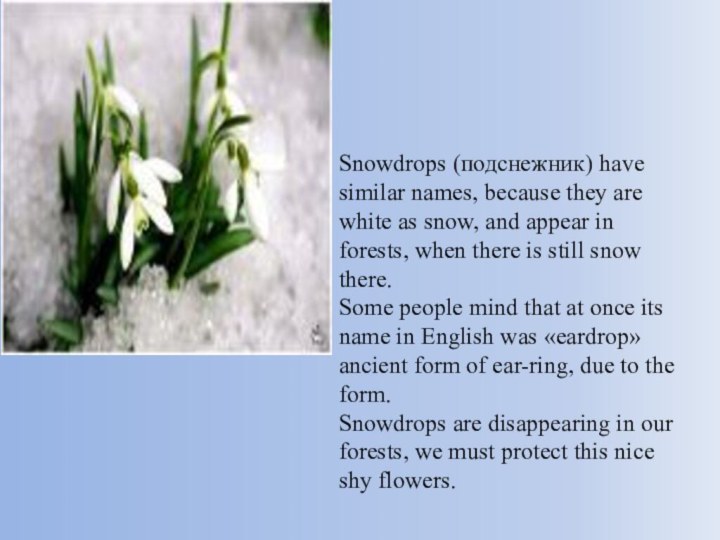

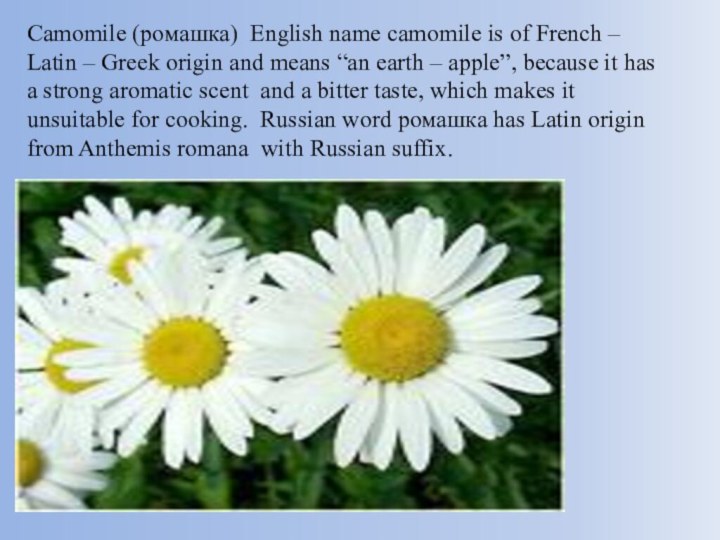
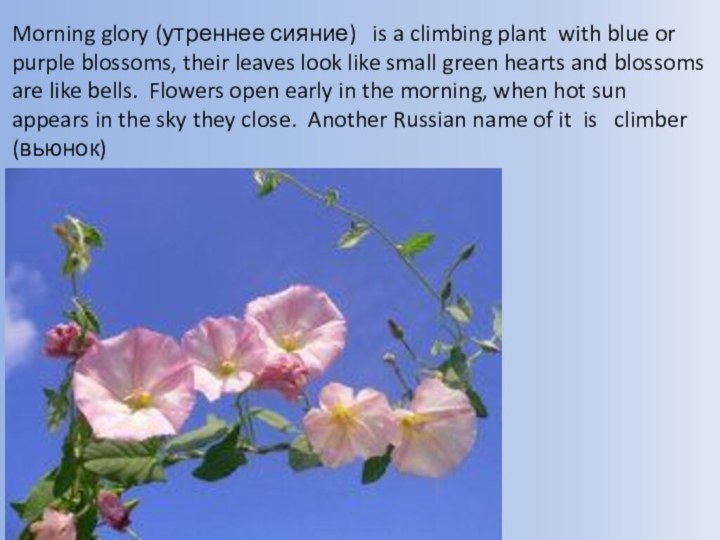

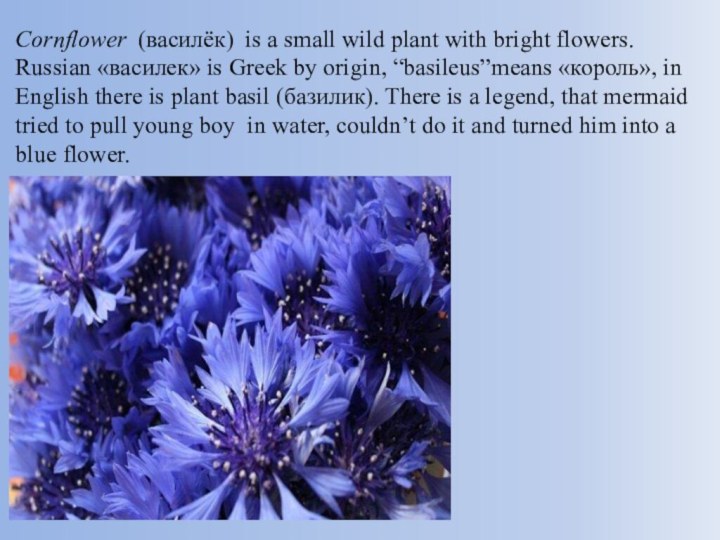
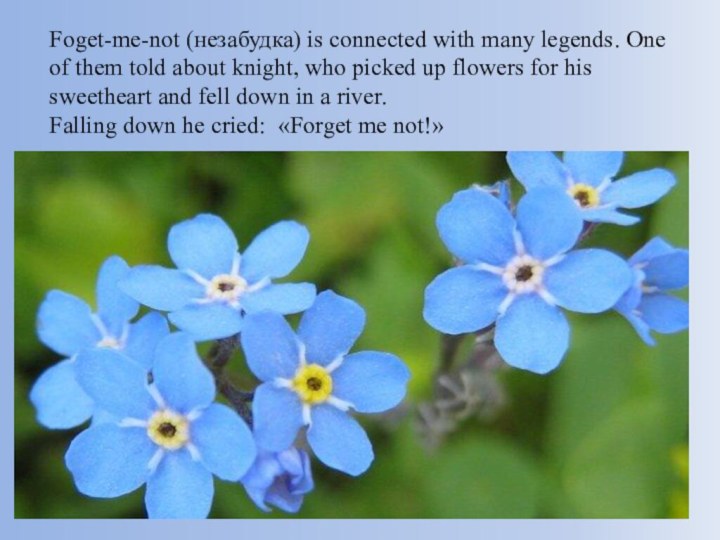
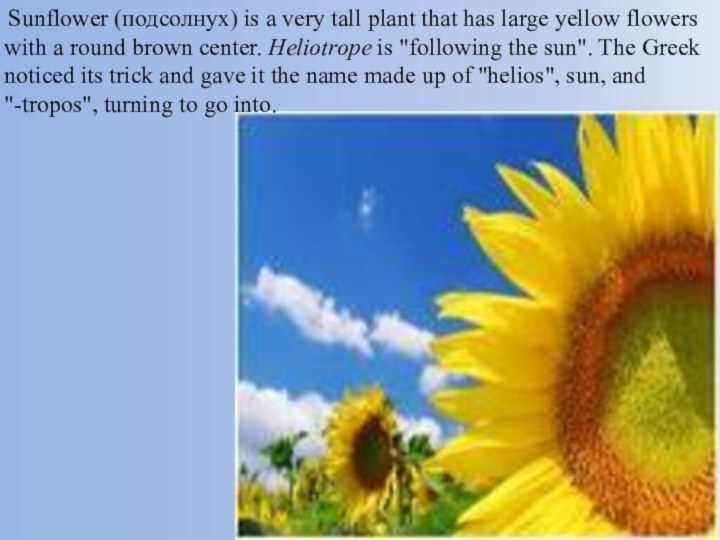
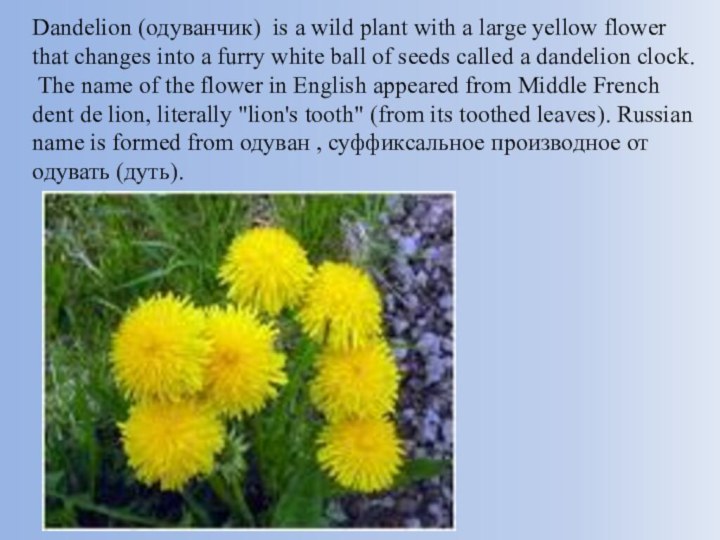
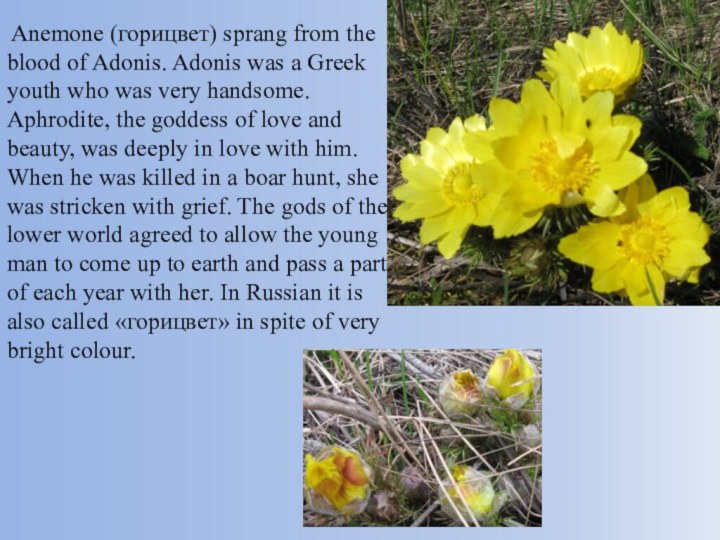
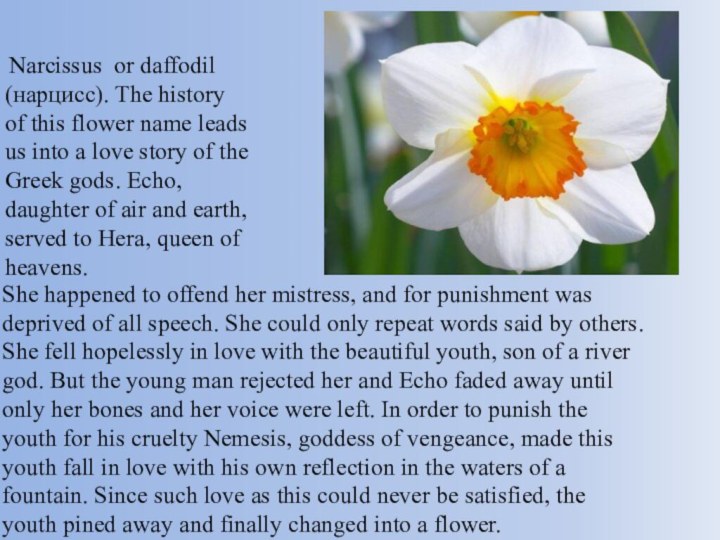
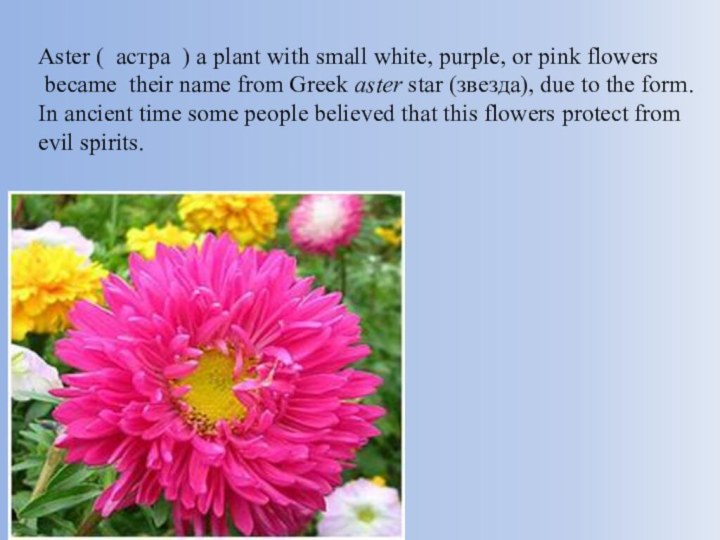
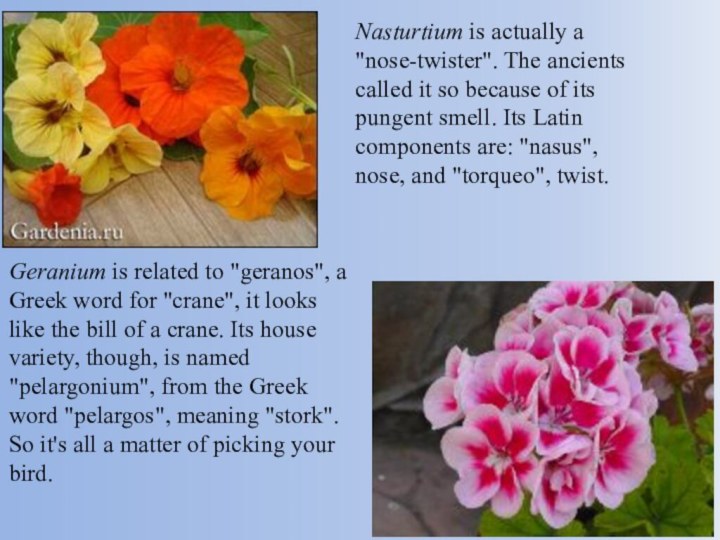
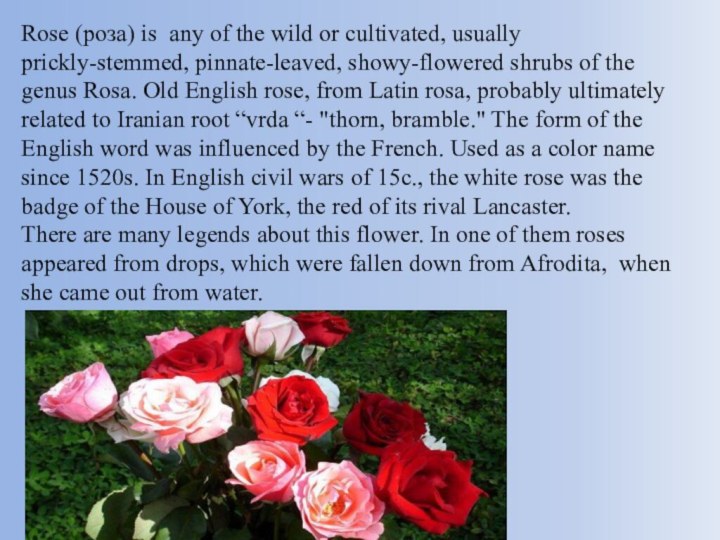
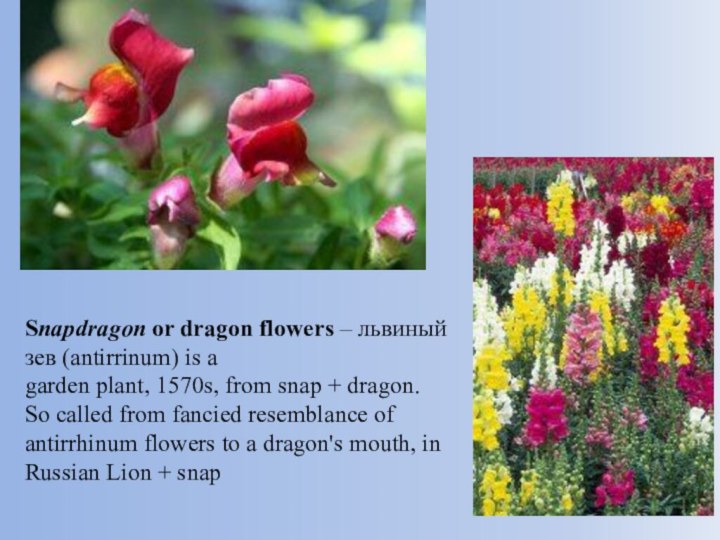
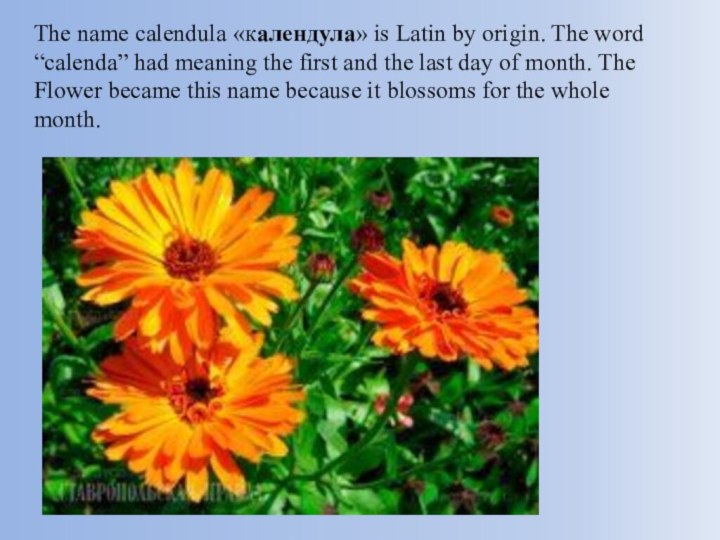
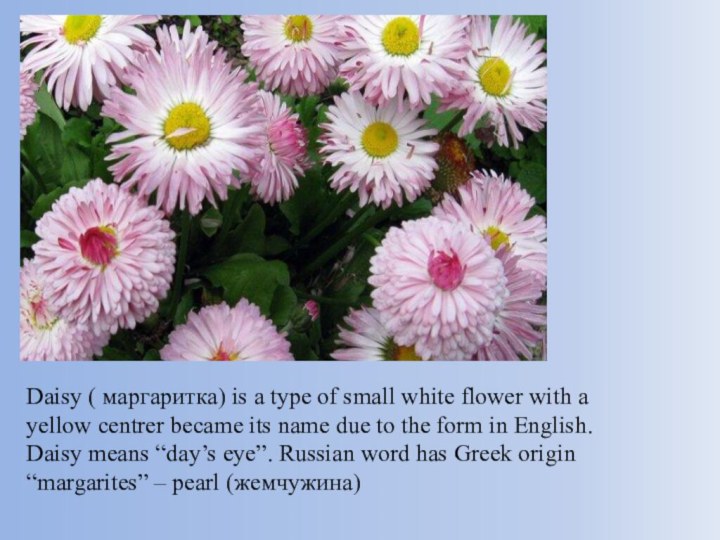
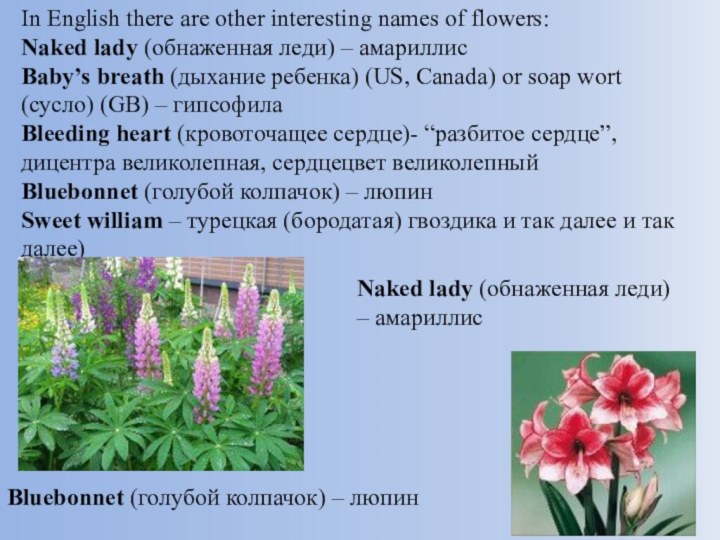

Слайд 3 I like nature very much. My favorite subject
is biology. I read a lot of books about
different plants. There are many flowers, which have similar names in English and Russian. Some names of the flowers have different pronunciation, but their meaning is similar. I try to tell you about origin of some names.Слайд 4 Snowdrops (подснежник) have similar names, because they are
white as snow, and appear in forests, when there
is still snow there.Some people mind that at once its name in English was «eardrop» ancient form of ear-ring, due to the form.
Snowdrops are disappearing in our forests, we must protect this nice shy flowers.
Слайд 5 One of the earliest spring flowers is primrose
(примула), (from Greek 'primus' — ранний, первый). Primroses can
be white, yellow, pink, purple and orange. The flowers look like small stars. They grow wild in many countries in Europe. In England people believed that fairies were living in these flowers. That’s why these flowers are very popular in Britain.Слайд 6 Camomile (ромашка) English name camomile is of French
– Latin – Greek origin and means “an earth
– apple”, because it has a strong aromatic scent and a bitter taste, which makes it unsuitable for cooking. Russian word ромашка has Latin origin from Anthemis romana with Russian suffix.Слайд 7 Morning glory (утреннее сияние) is a climbing plant
with blue or purple blossoms, their leaves look like
small green hearts and blossoms are like bells. Flowers open early in the morning, when hot sun appears in the sky they close. Another Russian name of it is climber (вьюнок)Слайд 8 Bluebell (колокольчик) is a plant that grows in
the countryside or in gardens, with small blue flowers
shaped like bells. In Russian the name of the flower appeared from Latin word “calo” (восклицать созывать), similar word is колокол.Слайд 9 Cornflower (василёк) is a small wild plant with
bright flowers. Russian «василек» is Greek by origin, “basileus”means
«король», in English there is plant basil (базилик). There is a legend, that mermaid tried to pull young boy in water, couldn’t do it and turned him into a blue flower.Слайд 10 Foget-me-not (незабудка) is connected with many legends. One
of them told about knight, who picked up flowers
for his sweetheart and fell down in a river.Falling down he cried: «Forget me not!»
Слайд 11 Sunflower (подсолнух) is a very tall plant
that has large yellow flowers with a round brown
center. Heliotrope is "following the sun". The Greek noticed its trick and gave it the name made up of "helios", sun, and "-tropos", turning to go into.Слайд 12 Dandelion (одуванчик) is a wild plant with a
large yellow flower that changes into a furry white
ball of seeds called a dandelion clock.The name of the flower in English appeared from Middle French dent de lion, literally "lion's tooth" (from its toothed leaves). Russian name is formed from одуван , суффиксальное производное от одувать (дуть).
Слайд 13 Anemone (горицвет) sprang from the blood of
Adonis. Adonis was a Greek youth who was very
handsome. Aphrodite, the goddess of love and beauty, was deeply in love with him. When he was killed in a boar hunt, she was stricken with grief. The gods of the lower world agreed to allow the young man to come up to earth and pass a part of each year with her. In Russian it is also called «горицвет» in spite of very bright colour.Слайд 14 Narcissus or daffodil (нарцисс). The history of
this flower name leads us into a love story
of the Greek gods. Echo, daughter of air and earth, served to Hera, queen of heavens.She happened to offend her mistress, and for punishment was deprived of all speech. She could only repeat words said by others. She fell hopelessly in love with the beautiful youth, son of a river god. But the young man rejected her and Echo faded away until only her bones and her voice were left. In order to punish the youth for his cruelty Nemesis, goddess of vengeance, made this youth fall in love with his own reflection in the waters of a fountain. Since such love as this could never be satisfied, the youth pined away and finally changed into a flower.
Слайд 15 Aster ( астра ) a plant with small
white, purple, or pink flowers
became their name from
Greek aster star (звезда), due to the form.In ancient time some people believed that this flowers protect from evil spirits.
Слайд 16 Nasturtium is actually a "nose-twister". The ancients called
it so because of its pungent smell. Its Latin
components are: "nasus", nose, and "torqueo", twist.Geranium is related to "geranos", a Greek word for "crane", it looks like the bill of a crane. Its house variety, though, is named "pelargonium", from the Greek word "pelargos", meaning "stork". So it's all a matter of picking your bird.
Слайд 17 Rose (роза) is any of the wild or
cultivated, usually prickly-stemmed, pinnate-leaved, showy-flowered shrubs of the genus
Rosa. Old English rose, from Latin rosa, probably ultimately related to Iranian root “vrda “- "thorn, bramble." The form of the English word was influenced by the French. Used as a color name since 1520s. In English civil wars of 15c., the white rose was the badge of the House of York, the red of its rival Lancaster.There are many legends about this flower. In one of them roses appeared from drops, which were fallen down from Afrodita, when she came out from water.
Слайд 18 Snapdragon or dragon flowers – львиный зев (antirrinum) is
a
garden plant, 1570s, from snap + dragon. So called
from fancied resemblance of antirrhinum flowers to a dragon's mouth, in Russian Lion + snapСлайд 19 The name calendula «календула» is Latin by origin.
The word “calenda” had meaning the first and the
last day of month. The Flower became this name because it blossoms for the whole month.Слайд 20 Daisy ( маргаритка) is a type of small
white flower with a yellow centrer became its name
due to the form in English. Daisy means “day’s eye”. Russian word has Greek origin “margarites” – pearl (жемчужина)Слайд 21 In English there are other interesting names of
flowers:
Naked lady (обнаженная леди) – амариллис
Baby’s breath (дыхание ребенка) (US, Canada) or
soap wort (сусло) (GB) – гипсофилаBleeding heart (кровоточащее сердце)- “разбитое сердце”, дицентра великолепная, сердцецвет великолепный
Bluebonnet (голубой колпачок) – люпин
Sweet william – турецкая (бородатая) гвоздика и так далее и так далее)
Naked lady (обнаженная леди)
– амариллис
Bluebonnet (голубой колпачок) – люпин


















